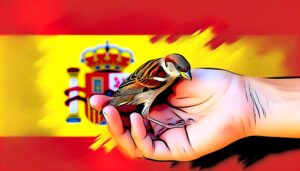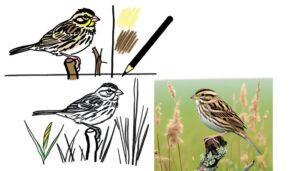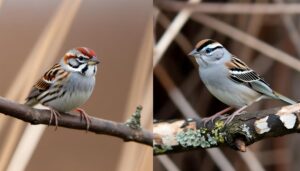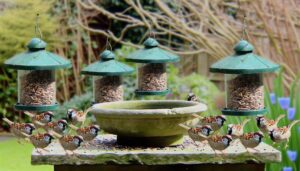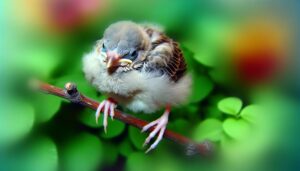Tame a Chipping Sparrow in 3 Easy Steps
Taming a Chipping Sparrow requires proper habitat, balanced diet, and patient interaction. First, mimic its natural environment with open space, low ground cover and a birdhouse for shelter.
Next, they'll need a diet rich in seeds, like millet and sunflower, supplemented with insects and berries. Fresh, clean water is essential too.
Finally, use a gentle, patient approach for interaction and monitor their behavior closely: prolonged silence or change in eating habits could indicate stress or health issues. Applying these fundamentals can yield amazing results, making a sparrow's unique chatter part of one's everyday experience.
Consider delving further to refine your methods for best outcomes.
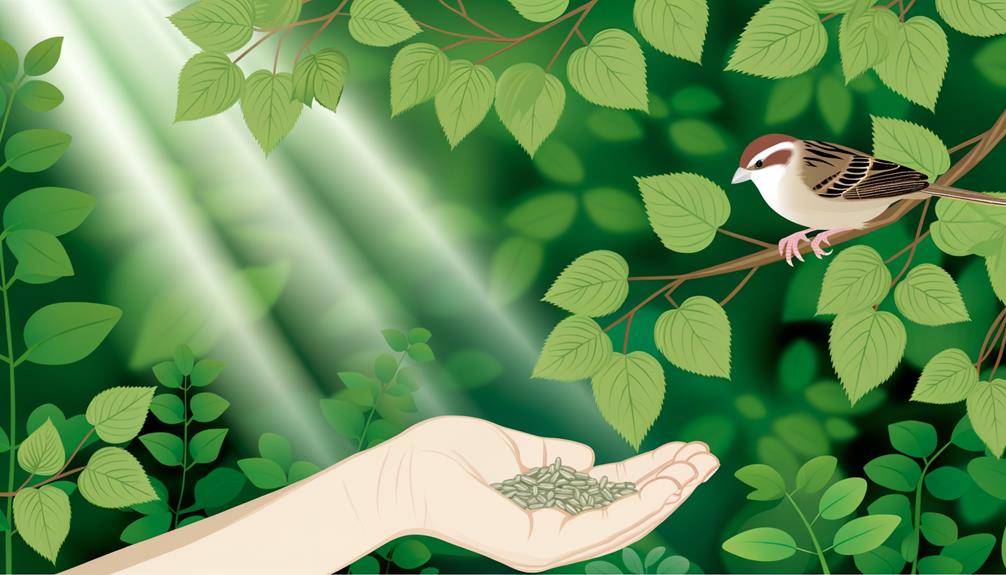
Key Takeaways
- Gradually introduce yourself to the sparrow, allowing it to become accustomed to your presence.
- Regularly provide high-quality seed blends and fresh water to make the sparrow more comfortable.
- Create a safe, stress-free environment by avoiding overcrowding and mimicking the sparrow's natural habitat.
- Observe the sparrow's behavior closely, noting changes in vocalization and eating habits as signs of comfort or distress.
- Positive reinforcement through gentle interaction can help build a bond with the sparrow.
Understanding the Chipping Sparrow
The Chipping Sparrow, scientifically known as Spizella passerina, is a spirited species renowned for its distinctive chipping sound and its vibrant rusty cap during the summer months. You'll often spot these small birds in open woodlands, parks, and backyards. They're easily distinguishable by their sharp, repeated 'chip' sounds, which they're named after.
During winter, their plumage dulls to a modest brown, a clever adaptation that helps them blend in with their surroundings. They feed mostly on seeds, but they won't turn their beaks up at a juicy insect or two. Understanding their feeding habits, preferred habitats, and seasonal changes in appearance is the first step in taming these lively creatures.
They're not naturally aggressive, but they're cautious and alert, making them a challenge to approach.
Creating a Safe Environment
To successfully tame a Chipping Sparrow, it's imperative to create a safe and welcoming environment that caters to their biological and behavioral needs. This involves providing the right type of shelter and ensuring there's sufficient space for them to move around freely.
| Essentials for a Safe Environment | Explanation |
|---|---|
| Appropriate Shelter | This can be a birdhouse or a cage. It should provide protection from predators, weather, and other potential threats. |
| Sufficient Space | The space should allow the bird to move freely, mimicking its natural habitat. Avoid overcrowding as it causes stress. |
Choosing the Right Feed
Having established a secure habitat, it's equally important to focus on what you're feeding your Chipping Sparrow, as their diet greatly influences their overall health and well-being.
- Seed Selection: Chipping Sparrows thrive on a diet primarily composed of seeds. Opt for high-quality mixed seed blends that include millet, cracked corn, and sunflower seeds. These provide necessary nutrients and are favored by the birds.
- Insects and Berries: During breeding season, they require protein-rich food. Hence, supplement their diet with mealworms or insects. Berries, such as juniper and elderberry, also offer essential vitamins.
- Fresh Water: Not technically feed, but it's essential. Always make sure clean, fresh water is readily available for hydration and bathing.
Methods of Attracting Sparrows
Several compelling methods can help attract Chipping Sparrows to your backyard, each requiring a careful balance of the right environment and food. To start with, these birds prefer open spaces with low ground cover. They're drawn to short, sparse grasses, making a well-maintained lawn an ideal habitat.
Next, while they eat a variety of seeds, they're particularly fond of sunflower seeds. As a result, a feeder stocked with these seeds can be a powerful lure.
Finally, sparrows are social creatures. They're more likely to visit a yard with a bird bath or a water source, as it provides opportunities for social interaction. It's important to keep these areas clean to prevent disease spread.
These methods, when combined, can significantly increase the chances of attracting Chipping Sparrows.
Importance of Patience
In the pursuit of attracting Chipping Sparrows, one mustn't overlook the key role patience plays. This avian fascination requires a measured approach, akin to the scientific method.
Observation:
Watch the sparrows' activities for patterns. They're creatures of habit, and discerning these habits needs time.
Experimentation:
Sparrows are wary of changes in their environment. Introduce new elements gradually and note their reactions. This process can be gradual.
Analysis:
Patience allows for thorough review of data gathered. It's the backbone of informed decision-making.
Interacting With Your Sparrow
As we proceed to the next phase of our discussion on 'Taming a Chipping Sparrow', the focus now shifts to 'Interacting With Your Sparrow'.
The primary topics to explore will include understanding the behavior of sparrows, building a relationship of trust with these birds, and mastering safe handling techniques.
These key points will provide a thorough approach to successful interaction with your chipping sparrow, further fostering a mutually beneficial relationship between you and your feathered friend.
Understanding Sparrow Behavior
Observing your sparrow's behavior over time, you'll notice they're highly social creatures, often engaging in playful interactions and complex communication. Sparrows use a range of sounds, movements, and behaviors to communicate, which varies from individual to individual.
- Vocalizations: Sparrows use diverse sounds to express different emotions. An understanding of these can aid in better interactions.
- Body Language: A sparrow's posture, wing movement, and feather fluffing can indicate its overall mood and comfort level.
- Social Interactions: Sparrows are communal, using intricate social behaviors to build relationships. Observing their interactions with other sparrows can provide insights into their behavioral patterns.
Understanding these aspects will help decipher the sparrow's behavior, leading to a more fruitful interaction, and furthering the taming process.
Building Trust With Sparrows
Building a bond of trust with your sparrow requires patience, understanding, and a gentle approach. It's crucial to respect their space initially, gradually reducing the distance as they become more comfortable.
Offering food, such as seeds, from your hand can help foster trust. However, sudden movements must be avoided, as sparrows are naturally skittish creatures. Consistency in your actions is key; a regular feeding schedule, for example, fosters familiarity and confidence.
Vocalizing softly when near the sparrow can also help, as they'll learn to associate your voice with safety and sustenance. It's important to remember that trust-building is a gradual process. It may require weeks, or even months, so it's essential not to rush the process.
Safe Handling Techniques
Safe handling of your sparrow demands precision, patience, and a gentle touch to ensure their comfort and health. It's vital to remember that these little creatures are fragile and they can be easily stressed or injured.
- Firstly, approach your sparrow slowly and calmly. Quick movements can startle them, causing unnecessary stress.
- Secondly, use a soft, covered hand to gently scoop them up. Avoid gripping too tightly as this can harm their delicate bones.
- Finally, hold your sparrow close to your body. This provides a sense of security and reduces the chance of them struggling or attempting to fly away.
Training Techniques for Sparrows
Implementing effective training methodologies, one can subtly guide a sparrow's behavior, harnessing their innate intelligence and adaptability. It's vital to maintain a calm, non-threatening environment, as sparrows are sensitive to stress. Gradual exposure to human presence, with care not to overwhelm the bird, is critical.
Positive reinforcement, such as rewards like treats, is a proven method in training. Sparrows can associate actions with rewards, encouraging repeat behavior. However, the timing of reward delivery must be precise to make sure the bird links the correct action to the reward.
Moreover, consistency in commands and gestures develops recognition patterns in sparrows. Repetition, patience, and respect for the bird's comfort zone are paramount. These are foundational techniques to effectively guide a sparrow's behavior.
Identifying Sparrow Behaviors
Observing and understanding sparrow behaviors is an essential step in successful training. Each chirp, flutter, or hop is a bird's way of communicating its needs, feelings, and responses. Identifying key behaviors involves a keen eye, patience, and a basic understanding of avian behavior.
Vocalization: Sparrows use a variety of chirps and songs to signal alarm, assert dominance, or attract mates. Prolonged silence could indicate stress or illness.
Body language: A fluffed-up sparrow may be attempting to regulate its body temperature, while aggressive pecking might suggest territorial disputes.
Eating habits: Sparrows typically forage for seeds and insects. Changes in their diet or feeding behavior can reveal health or environmental issues.
Recognizing these behaviors helps in understanding and responding to a sparrow's needs, thereby ensuring effective training.
Health and Wellness Tips
As they move forward, they must address the vital subject of maintaining the health and wellness of a Chipping Sparrow.
It's essential to explore two key aspects: the balanced diet necessary for these small birds and the importance of promoting regular physical activity.
These factors not only guarantee the bird's physical well-being but also greatly impact its behavior, making it more receptive to taming efforts.
Balanced Diet for Sparrows
Ensuring your sparrow receives a balanced diet, it's important to take into account a mix of seeds, fruits, and insects, which are essential to their health and well-being.
Seeds: Chipping sparrows primarily feed on seeds. They favor grass seeds but will also consume a variety of other types. Seeds should constitute a significant portion of their diet, providing essential vitamins and minerals.
Fruits: Fruits, particularly berries, offer a range of nutrients. They're rich in antioxidants, promoting optimal bird health.
Insects: Insects are an optimal protein source for sparrows, especially during breeding season. They help in the growth and development of young sparrows.
Promoting Sparrow Exercise
How can one ensure their sparrow gets enough exercise, you might wonder? Providing a spacious cage for your feathered friend is crucial. This allows ample room for flapping and hopping, integral movements for maintaining sparrow health.
In addition, introducing elements like swings, ladders, and mirrors can encourage physical activity.
However, one mustn't overlook the significance of mental stimulation. Introducing new toys or changing the cage setup keeps the sparrow's environment engaging, promoting exploration and movement.
Lastly, remember that wild sparrows are social creatures, often seen in flocks. Hence, interaction with other birds or humans can be a form of exercise.
Promoting exercise isn't just about movement; it's about creating a stimulating, dynamic environment for your sparrow.
Forming a Bond With Your Sparrow
Building a trusting relationship with your chipping sparrow involves understanding its unique behaviors, needs, and responses to stimuli. Bonding is a process that requires patience, time, and consistency.
Here are three principal steps to accomplish this:
- Observe: Study your sparrow's habits, reactions, and body language. This will provide insight into its preferences and dislikes, facilitating a more effective bonding process.
- Interact: Gradually introduce yourself into the bird's space. Use soft, soothing tones, and avoid sudden movements to prevent agitation. Regular interaction will help the bird acclimate to your presence.
- Reward: Positive reinforcement, like providing favorite foods after interactions, will associate your presence with pleasant experiences.
Ongoing Care for Chipping Sparrow
Once a bond with your chipping sparrow has been established, it's important to focus on providing the necessary ongoing care. This includes a balanced diet, regular vet check-ups, and a safe, stimulating environment.
A balanced diet for a chipping sparrow should contain a variety of seeds, fruits, and insects, mimicking their natural diet in the wild. Regular vet check-ups facilitate early detection of potential health issues. A stimulating environment can be achieved by providing safe toys and enough flying space.
Ongoing care is a critical element in ensuring the health and happiness of the sparrow. It requires time, commitment, and a thorough understanding of the sparrow's needs. However, the rewards of seeing your sparrow thrive are immeasurable.
Conclusion
After an epic journey through sparrow psychology, habitat creation, and gourmet birdseed selection, we've reached the pinnacle of chipping sparrow taming.
With an abundance of patience, keen observation skills, and a deep understanding of their health needs, you're now ready to form a bond with these feathered friends that's as strong as steel.
Remember, diligent care is vital for your sparrow's well-being.
May your life be filled with the sweet chirps of a content chipping sparrow!

